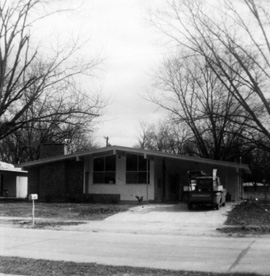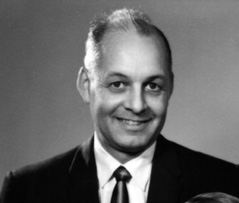Biographical Notes reCharles A. (Chuck) StonePage 1 of 3 Pages, of Chapter 8,EXPANDING HORIZONS |
|||||||||
 |
|||||||||
| Checking in at the Barksdale AFB Base Housing Office, we discovered we had been outfoxed or outranked for the promised base housing accomodations. After learning where I would work and meeting my new boss and office-mates, Nell, the children and I set out to find a place to live. Rental housing was almost non-existant. We learned there was some kind of an FHA housing scandle in progress and there was an excess number of newly-built houses for sale. We selected the one we thought best for our needs and signed on for the purchase and mortgage. It didn’t take long for us to have the children in school and go about nourishing our roots in the community. |
|||||||||
|
|
|||||||||
| I found the Director of Ground Training and his staff to be warm, welcoming and enjoying their work and life at Barksdale. My work assignments were much like that at Lincoln, only with a broader sweep. I would manage the small arms marksmanship and shooting competition, physical fitness, combative measures, code of conduct and related programs for the Numbered Air Force. Being so glad to be regaining my health and hope made each day a joy. I soon found myself taking the stairs two at a time and discovering I had forgotten to wear my steel brace. It wasn’t long and I could use it for a parlor decoration, as my body was doing well on its own. A few months on the job and I was back into getting some physical exercise and flexibility movements in my routine. A bit more of that and I reported into the Flight Surgeon’s office and asked to be returned to flying status. He put me through the mill and stamped me as OK to fly. Hallelujah!!! |
|||||||||
 |
|||||||||
|
|
|||||||||
| The staff officer in our office who was responsible for 2nd AF simulator programs had the desk next to mine. He was also a C-54 IP and soon had me in the left seat of one of the Headquarters C-54s and I was back in the saddle again. As I had hoped, I again had two main jobs, one in the training office and the other included frequent flights around the country carrying IG Inspection Teams and other staff transport and cargo missions. There were occasions where I had the Commander of 2nd AF, General McConnell, as a passenger. I had learned to love his leadership style and had growing opportunities to get to know him on a more personal level. A very down-to-earth aviator, officer and gentleman. As I got deeper into my training program development and management duties, I increasingly realized that the busy atmosphere of the SAC working climate made allowing special time for ground training a low priority for busy operations and scheduling personnel. Ground Training, as such, did not launch aircraft, locate and bomb targets, fill the most meaningful squares, and enhance the organization in the eyes of the SAC Commander, making my job a pretty steep climb. I focused my efforts to understand the problems better and looked for innovative solutions. On the home front, having a son at the right age, I became part of a neighborhood movement to form a Cub Scout Pack in the area. With no lobbying on my part, I found myself as CubMaster to this group. The fruits of this effort were many, but I must tell you about one of them that was most heartwarming. As Christmas, 1960, approached, we voted to initiate a help-effort for some of the least advantaged local families we could identify. Working with local social services, we came up with family names, children’s ages, locations, etc. Each of our Cub Dens, slected a few of the families to work for, specifically. Parents refurbished or purchased toys to suit each child. We conducted an area wide clothing drive that filled our home to the living room ceiling with assorted clothing. Each Den sorted through the collection and identified clothing that would fit each family member of the families on their list. All left-over clothing was turned over to a local agency and we were told there were people lined up around the block, selecting items for their needs. When Christmas came, each of our Den families packed up their collections for their selected needy families. They, as a family, made the deliveries to the recipient families. A truly grand experience and education for all concerned. This effort was well recognized by the local community as well the entire complement of Barksdale AFB and 2nd AF Headquarters. Small Arms Training was a hard nut to crack. On 14 January, 1958, General Carmichael, USAF Director of Personnel Procurement and Training, had advised all major commands that small arms training was being reinstated in the Air Force for all personnel.The new Air Force had come to believe that the Army’s and Marine’s job was to stand by, guarding the Air Force so it could do its all-important work. They had not yet experienced, out of pure survival necessity, the abandonment of that practice as it would occur later in Viet Nam when Marines and Army troops were somewhere else and the enemy was overrunning Air Force installations while the USAF troops were unpacking M-16 (AR-15) rifles from packing cases and wondering where the bullets fit. They also wondered why the weapons were sometimes corroded and unfit for immediate use. While this challenge was weighing on my mind, I signed up for the Squadron Officer’s Course (SOC), via correspondence, as a personnel career enhancement move. The studies and grades on my work were going well and I reached the point where I had to pick an existing problem and develop a Staff Study that identified a proposed solution(s). My decision was to do a Staff Study regarding my most pressing challenge which was how to make small arms training more available and acceptable to our already overscheduled SAC personnel. At the same time, while fulfilling my C-54 transport duties, I was traveling from base to base and often stopping overnight. When time permitted, I would look into conditions and facilities that related to my work, at that base. I took along my Nikon Camera and photographed anything that might look interesting. To my delight, I got an A grade on my presentation from my SOC teacher monitors. This complete, I found I couldn’t stand to just put that document on the shelf after all that work. The next logical step was obvious. I began to make a color slide presentation out of it so the ideas presented could be shared with others in group meetings. My photos, collected during TDY missions, began to find their place in my presentation. As this process progressed, I began drafting out a companion 2nd AF Manual entitled “Small Arms Marksmanship Training”. Keep in mind that I was no “shooter” or “gun nut”. I truly believed that my sense of neutrality in doing my job, helped me sort out a balance between the gun nuts and jock straps, that believed we should all be at the base gym or shooting range on a daily basis, and those with opposite views, was my chief value as a training program developer and manager. This certainly came into play on the assignment that followed this current one at 2nd Air Force Headquarters. |
|||||||||
|
End of Page 1 of 3 Pages, Chapter 8 — Go to Page 2 Click below to select a destination Go to Page 1 — 2 — 3, this Chapter Chapters 1 — 2 — 3 — 4 — 5 — 6 — 7 — 8 — 9 — 10 |
|||||||||